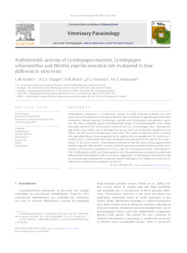Anthelmintic activity of Cymbopogon martinii, Cymbopogon schoenanthus and Mentha piperita essential oils evaluated in four different in vitro tests.
Anthelmintic activity of Cymbopogon martinii, Cymbopogon schoenanthus and Mentha piperita essential oils evaluated in four different in vitro tests.
Author(s): KATIKI, L. M.; CHAGAS, A. C. de S.; BIZZO, H. R.; FERREIRA, J. F. S.; AMARANTE, A. F. T.
Summary: Anthelmintic resistance is a worldwide concern in small ruminant industry and new plant-derived compounds are being studied for their potential use against gastrointestinal nematodes. Mentha piperita, Cymbopogon martinii and Cymbopogon schoenanthus essential oils were evaluated against developmental stages of trichostrongylids from sheep naturally infected (95% Haemonchus contortus and 5% Trichostrogylus spp.) through the egg hatch assay (EHA), larval development assay (LDA), larval feeding inhibition assay (LFIA), and the larval exsheathment assay (LEA). The major constituent of the essential oils, quantified by gas chromatography for M. piperita oil was menthol (42.5%), while for C. martinii and C. schoenanthus the main component was geraniol (81.4% and 62.5%, respectively). In all in vitro tests C. schoenanthus essential oil had the best activity against ovine trichostrongylids followed by C. martini, while M. piperita presented the least activity. Cymbopogon schoenanthus essential oil had LC50 value of 0.045 mg/ml in EHA, 0.063 mg/ml in LDA, 0.009 mg/ml in LFIA, and 24.66 mg/ml in LEA. The anthelmintic activity of essential oils followed the same pattern in all in vitro tests, suggesting C. schoenanthus essential oil could be an interesting candidate for nematode control, although in vivo studies are necessary to validate the anthelmintic properties of this oil.
Publication year: 2011
Types of publication: Journal article
Observation
Some of Embrapa's publications are published as ePub files. To read them, use or download one of the following free software options to your computer or mobile device. Android: Google Play Books; IOS: iBooks; Windows and Linux: Calibre.
Access other publications
Access the Agricultural Research Database (BDPA) to consult Embrapa's full library collection and records.
Visit Embrapa Bookstore to purchase books and other publications sold by Embrapa.

